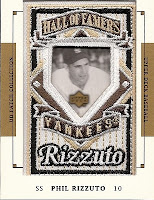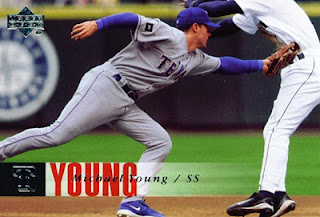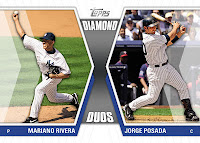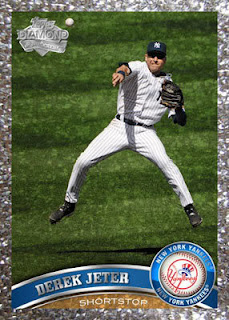If you've read some of my other posts, you know a bit about my history. This is the whole story (ooh, shocking). This also introduces my want lists, which can be seen by looking at the sidebar.
I've already mentioned I started in '89 with a rack pack of Topps. The first few years after that were spent learning about the hobby. My first big purchase was a Jose Canseco 1986 Donruss RC (wow, great investment!), because he was at the time my favorite player. I quickly discovered card shops in the San Francisco bay area - in San Francisco, there was a shop on 18th Avenue near Judah, in Santa Clara, I would head over to Stevens Creek Sports Cards (still in business today), and when I convinced my grandmother to take me across the bay on BART, there was a store in Berkeley that I believe was near the university. Since I lived in Santa Clara, I would visit Stevens Creek most often. I've never seen a store like them to this day (I'm sure they exist). For those that have never been, they really do have it all - singles in cases, commons in boxes throughout the store, packs, boxes, supplies, figurines, souvenirs. I would go in there with a couple bucks or my mom and come out with a few packs of Topps, Donruss, Fleer, or Score. I believe I opened one or two packs of Stadium Club, Leaf, and Ultra. If I couldn't get to the store (by bus it took about 20-30 minutes each way), I could walk to the corner store (who we called Crooks for being so overpriced), or the long block to the Walgreens and grocery store in the strip mall, or the 7-Eleven the long block in the other direction.
In early 1992, I moved to Georgia, away from all the baseball card stores and public transit. In fact, there wasn't much of anything to do in the area (and still really isn't). There's a batting cage that's been around for decades, but even though that wasn't too far away I had to get a ride (ever try to walk on busy country roads without sidewalks?). Getting packs of cards meant going a long distance to K-Mart or even farther to WalMart. But my grandma would support my habit by having boxes and supplies shipped from Stevens Creek. This continued for about three to four years. During that time, a card store opened in my hometown, run by a former Mets minor leaguer. Eventually I was old enough to work, and most of my paycheck went to card boxes - I'd buy a box or two of pretty much every issue, and never really finish a set. He had some singles - he must have had one of his customers sell back inserts and such they didn't want - but he never opened product for set builders. So I'd open a box, be happy with what I got, go home and sort it and add it to the list, put it in a box or binder, and never think of it again. This happened for a few years, and well, without focus, I lost interest. I had become extremely interested in music and movies, and by 1998 I was working at Blockbuster, shopping on eBay for movie stuff, and I just kind of stopped buying stuff. This was during the great McGwire/Sosa steroid shoot-up competition, so I sold off my cards of the two players on eBay (and made a fortune, really), condensed the rest into boxes, and waited for the motivation to sell off the bulk. That day never came - my cards moved around my room and eventually into storage.
I didn't quit collecting cards. I'd see something non-sport in the store, or come across an auction on eBay, and I'd pick up a movie set or autograph here or there, but nothing baseball. My non-sport collection actually grew pretty big (it still is fairly large), and in search of new and exciting cards I started going to card shows in late 2003. I was back into collecting.
Browsing the show I saw so many new things I hadn't ever seen before - relic cards (I had heard of them back in '96, and was aware of them because of the non-sport cards, but didn't know they were so prevalent), new brands and sets, autographs galore, and all that "vintage" 1990s stuff that I had never bothered to finish or couldn't find. I had to have a focus this time, though. I knew I couldn't afford to spend $500-1000 on boxes every month to keep up with the new releases, and with so much out there I couldn't possibly buy everything anyway.
My first collection, which I don't have anymore, was Tony Gwynn and Nolan Ryan. They were my heroes as a young adult (after Canseco faded away from my mind), so I tried to get one of every Gwynn and Ryan card. I quickly realized that was impossible, with 1 of 1s and autographs being way out of my budget if I could even find them. Actually, I still have most of the cards, but they're in the piles of "extras" boxes. I could pull them out and refocus those collections later if I desire.
I decided that I wanted to try and collect a sample from every major set ever released. This would be issues from the big manufacturers, including some of the oddball sets, as well as some of the larger other issues, like the Exhibits, SSPC, TCMA, and Post. Overall, this represented approximately 1800 releases. I called this the "Master" collection, and I still keep a list for this collection - there are 225 card sets on this list through 2009 I don't have representation from. Some cards I need value in the hundreds of dollars (Cracker Jack or American Caramel, anyone?).
Of course, that wasn't enough, so I started a new aspect to my collection.
This Card Is Cool. I went page by page through the Beckett Almanac and picked out any sets I thought were cool. That was the aspect. They went into one of two categories (now combined): sets to complete, and cards. The sets were generally art cards, such as Gallery and Diamond Kings, in addition to the Upper Deck Baseball Heroes series. The cards were generally what others would consider gimmick sets, like acetate and metal cards. There are 240 sets in the "This Card Is Cool" collection, of which about 130 are not complete (some of them not even started). (The Diamond Kings and Baseball Heroes sets not included in this count).
I expanded the Master Collection into something even greater - the Super Collection (my naming skills are awesome, right?!). One card from every set issued, ever. By the end of 2010, the collection's size is 32000, of which I'm a bit less than 17% done. What do I need? Team issues and other truly oddball releases, minor league team sets, and plenty of relics/autos, inserts, and parallels.
I was inspired to put together my own frankensets representing winners of awards, leaders in statistical categories, world series teams, hall of famers, and no-hitter pitchers. Well over 3000 cards are involved in these sets, and I still need over 1600. I'm also considering putting together all-star team sets for each year, but that's a future project. I need to finish some of what I have now.
I have a
small autograph collection, consisting of perfect game pitchers, unassisted triple play fielders, certain Braves, Giants, A's, and Tigers players, and a few other players I admire.
My most recent collection is a spinoff of the Master Collection, which started with an attempt to collect a complete set of Topps for every year 1951-current. Checking my want list, you'll see that it's nowhere near finished (and honestly, if I can complete 1978-current I'll be quite proud). I recently added Upper Deck, Donruss, Fleer, and Score. Newest is Stadium Club, mainly for the photography.
I also had a Significant Sets collection started - the first Topps, Upper Deck, Donruss, and Fleer sets, which are already covered. This collection also includes '48 Bowman (not started), '90 Leaf, '92 Topps Gold, '93 Flair (all complete), and '93 Finest (not started).
I look at all these collections and think, wow, that's a lot. But when you get down to it, in the age of the internet, many of these concepts are easy to finish, if not costly. It's definitely a focus on quantity, but to me there is also a good bit of quality. Not in the cost (autos/relics only fit in the super collection and my small player collection), but in what it represents. The cards are ones that interest me and there's a meaning for each part of my collection.
Interestingly, I don't collect a team, other than Team USA. I've never really attached to a specific team over the years. I was a Giants and A's fan when I first started collecting, but I was thrown into the Braves excitement in 1992 when I moved to the Atlanta area. I still like the Braves, but coming back to California, I find that going to A's games could be a good bit of fun, and I've been visiting a lot of minor league teams over the past few years. But I don't really have much of an interest in collecting team sets of any of them. I guess I already have my hands full?
Thoughts? Questions? Comments? That's what there's space for just below this!












































